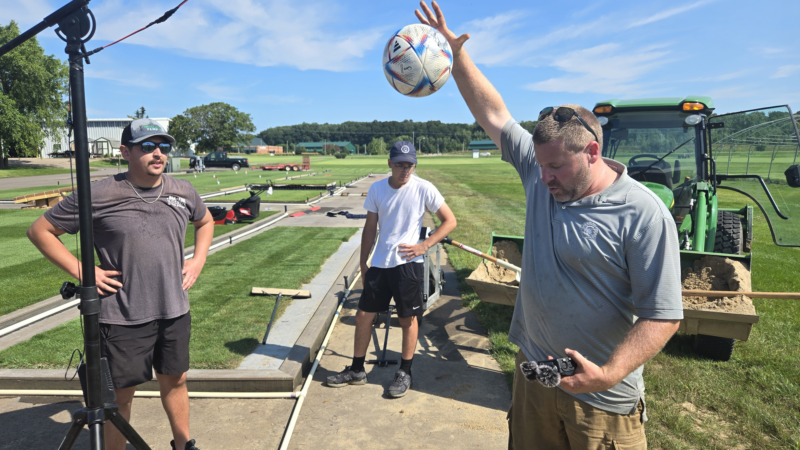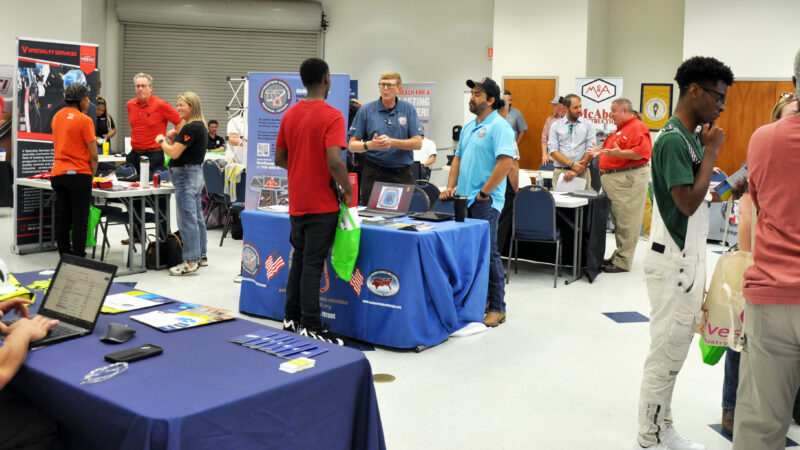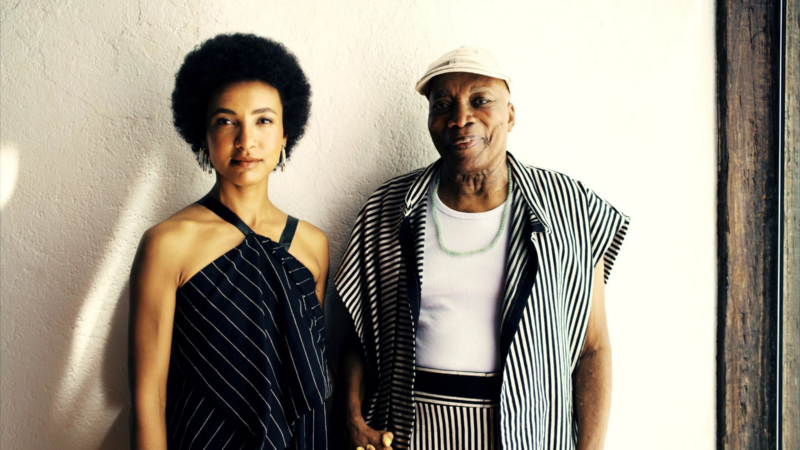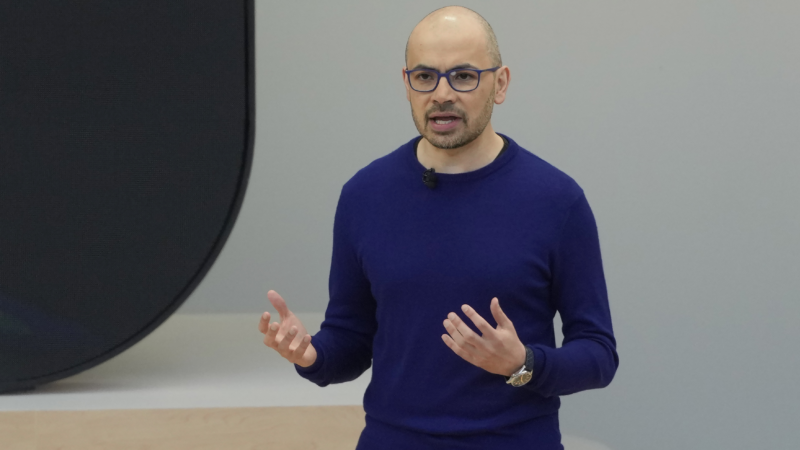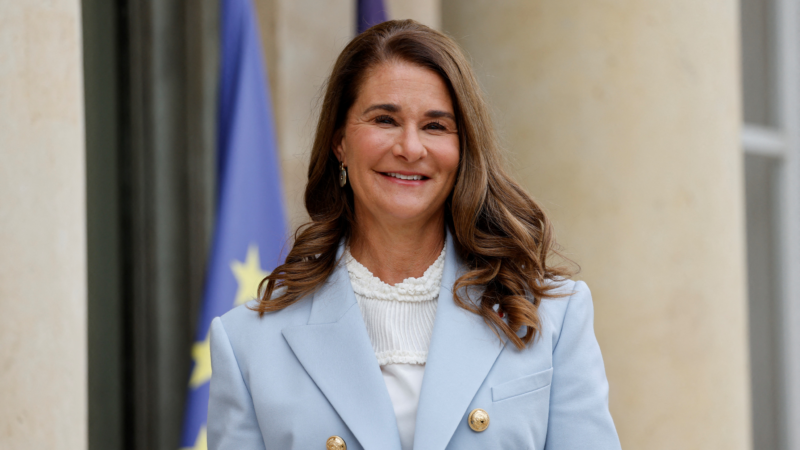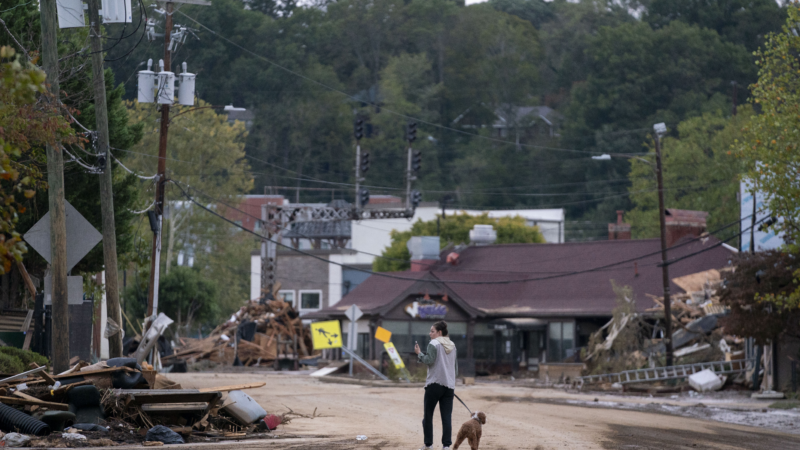Researchers work to make pitch-perfect turf for the 2026 World Cup
In less than two years, one of the world’s biggest sporting events will be held in North America.
The United States, Mexico and Canada will host the 2026 World Cup holding games in 16 cities.
Researchers have spent years making sure the grass in each venue will be in prime condition and will have a consistent feel for the world class athletes racing up and down the field.
A history-making turf experiment
In 1994, soccer fans attended the first ever FIFA World Cup tournament held on U.S. soil.
The Pontiac Silverdome, outside of Detroit, Michigan, was one of nine venues for the event and it was the first time World Cup games were played indoors. Michigan State University researchers grew and brought in grass specifically for the stadium.
John Sorochan was an undergrad at the time and helped with the history-making project. He says he remembers being nervous trying to drive his mower straight down the field because of the amount of eyes on him
“We’re mowing back and forth, I had to keep stopping to hand clippings of the grass to the fans.”
The Silverdome’s roof meant researchers had to find a way to grow grass that could remain healthy without natural light. Trey Rogers, a MSU professor of turfgrass management, says they developed a system of planting sod on plastic lining.

(Sophia Saliby | WKAR)
“The sod would grow into this box, and then we would move it inside, but it was well-rooted,” he said. “All it had to do was survive that period of time, in those games,” he said.
Rogers says the experience made him wonder what else could be done.
“I’ve been thinking about this for 30 years, but we didn’t have anybody with the funding to push it forward,” he said.
FIFA support helps the pitch
Now with dollars from FIFA, there’s work underway to make sure the grass is just right for the 48 soccer teams playing in the 2026 World Cup.
“The pitch is everything,” said Alan Ferguson, FIFA’s head of pitches.
“It’s the stage on which the players perform, and we are the guys that give them that stage.”
So, Rogers and Sorochan, who’s now a turfgrass scientist at the University of Tennessee Knoxville, and their teams are studying how to manage 16 pitches in several different climates to make sure athletes don’t have to worry about the ground underneath them.
“They don’t want to be thinking about the footing and slipping, or how it’s going to be different from one stadium to the next if they’re playing a game,” Sorochan said.
Since 2021, there have been more than 70 experiments from Sorochan and Rogers’ teams from researching different ways to remove dead grass from the field to finding the best method to incorporate synthetic fibers into the natural turf to make it last longer.
In one experiment, a group of MSU students pack different levels of sand between asphalt and a layer of turf grass. They then drop a soccer ball on the grass and measure the sound of its bounce.
It is all about determining if the ball’s first bounce meets tournament regulations by reaching a height of 60-100 centimeters.
This detailed measuring can also be used in the future to better understand ways to use stadiums not built specifically for soccer games.

(Sophia Saliby | WKAR)
A grass field not only for soccer
Sorochan says he’s already thinking about more ways their work can have an impact outside the sport.
“All of this research is enabling us to have a legacy of research that will go and hopefully continue beyond 2026 but that will help professional soccer stadiums all over the world to professional baseball and NFL fields to college to even little city park and rec fields,” Sorochan said.
Professor Rogers says their students will be making a mark, just like he did 30 years ago when he helped develop the grass for the World Cup games at the Pontiac Silverdome.
“I think all of them will remember this for the rest of their lives. I know that ‘94 burns in my mind, even every day,” he said.
The first big test of this latest turf project will be next year. FIFA will hold a new version of its Club World Cup in the United States for international teams representing soccer confederations. Then the turf will be grown for the prestigious 2026 World Cup.
Transcript:
LEILA FADEL, HOST:
What makes a soccer field’s grass worthy of hosting a World Cup match? The event’s governing body, FIFA, sets standards for that. As the U.S., Mexico and Canada prepare to host the 2026 World Cup, researchers and college students here in Michigan are working to make sure the grass at each stadium is pitch perfect. Sophia Saliby of member station WKAR reports.
SOPHIA SALIBY, BYLINE: It was 30 years ago – 1994 – when the World Cup tournament was first played on U.S. soil.
(SOUNDBITE OF ARCHIVED RECORDING)
UNIDENTIFIED COMMENTATOR: This is the Silverdome in Pontiac, Mich. – 77,577 on hand to see the United States take on Switzerland.
SALIBY: The Pontiac Silverdome was one of nine venues. It was the first time a World Cup game was played indoors. Michigan State University researchers grew and brought in grass specifically for the stadium. John Sorochan was an undergrad at the time and helped with the history-making project.
JOHN SOROCHAN: We were mowing back and forth. I had to keep stopping to hand clippings of the grass to the fans.
SALIBY: And Trey Rogers, an MSU professor of turfgrass management, says the whole experience of developing a way to keep that grass alive made him wonder what else could be done.
TREY ROGERS: I’ve been thinking about this for 30 years, but we didn’t have anybody with the funding to push it forward.
SALIBY: Now, with dollars from FIFA, there’s work underway to make sure the grass is just right for the 48 soccer teams playing in the 2026 World Cup.
ALAN FERGUSON: The pitch is everything.
SALIBY: Alan Ferguson says the pitch – or the soccer field – is everything. He’s the head of pitches for FIFA.
FERGUSON: It’s the stage on which the players perform, and we’re the guys that give them that stage.
SALIBY: Those guys are Ferguson, Professor Rogers and that former undergrad, John Sorochan, who’s now a turfgrass scientist at the University of Tennessee, Knoxville. They, along with their teams, are studying how to manage 16 pitches in several different climates to make sure athletes don’t have to worry about the ground underneath them.
SOROCHAN: They don’t want to be thinking about the footing and slipping, or how it’s going to be different from one stadium to the next, if they’re playing a game.
SALIBY: So for the past three years, the scientists have been conducting experiments, like this one being led by MSU researcher Ryan Bearss.
SALIBY: Bearss and a group of students are packing different levels of sand between asphalt and a layer of turfgrass.
RYAN BEARSS: This is nonstabilized ball rebound over field turf, 5 inches sand infill.
SALIBY: They drop a soccer ball on the grass and then measure the sound of its bounce.
(SOUNDBITE OF BALL BOUNCING)
SALIBY: It’s all about determining if the ball meets tournament regulations. On first bounce, it has to reach a height of 60 to 100 centimeters. It is detailed measuring that can also be used in the future to better understand ways to use stadiums not built specifically for soccer games. And Professor Rogers says the students will be making a mark – just like he did 30 years ago, when he helped develop the grass for the World Cup games at the Pontiac Silverdome.
ROGERS: I think all of them will remember this for the rest of their lives. I know that ’94 burns in my mind even – every day.
SALIBY: The first big test of this latest turf project will be when FIFA holds a tournament for club soccer in the United States next year. Then the turf will be grown for the prestigious 2026 World Cup.
For NPR News, I’m Sophia Saliby in East Lansing.
(SOUNDBITE OF THE MUSES’ “WAKA WAKA”)
Alabama’s construction industry is in dire need of workers. Here’s how companies are responding
Nationally and in Alabama, a construction-workforce shortage has stretched for decades. Now, as increased demand after the pandemic shows no signs of slowing and as billions of dollars in federal funding for infrastructure and manufacturing projects flows to states, the problem is growing.
Time is short to evacuate for Hurricane Milton. And, EPA mandates lead pipe removal
Hurricane Milton is expected to make landfall in Florida late tonight as a dangerous storm, and time is running out for people to evacuate. And, the EPA has mandated a nationwide lead pipe removal.
Tune in to a mini-concert with esperanza spalding and Milton Nascimento
The pair perform songs from their collaborative jazz album, Milton + esperanza.
Nobel Prize in chemistry awarded to scientists for work on proteins
The Nobel Prize in chemistry was awarded Wednesday to David Baker, Demis Hassabis and John Jumper for their work with proteins. The awards continue with the literature prize on Thursday.
Only 2% of charitable giving goes to women. Can Melinda French Gates change that?
The philanthropist is spending $1 billion — and leveraging her ever-growing celebrity — to call more attention to the systemic problems facing women and girls. Now she's focusing even more on women's health.
They came to Asheville looking for a ‘climate haven.’ Then came Hurricane Helene
When Mary Ann Roser and her husband moved to Asheville four months ago they introduced themselves to neighbors as “climate refugees from Austin.” After Helene, she has thoughts on “climate havens."
